Reconstructing Ashkenaz: The Human Face of Franco-German Jewry, 1000-1250
Reconstructing Ashkenaz shows that, contrary to traditional accounts, the Jews of Western Europe in the High Middle Ages were not a society of saints and martyrs. David Malkiel offers provocative revisions of commonly held interpretations of Jewish martyrdom in the First Crusade massacres, the level of obedience to rabbinic authority, and relations with apostates and with Christians. In the process, he also reexamines and radically revises the view that Ashkenazic Jewry was more pious than...
Search in google:
Reconstructing Ashkenaz shows that, contrary to traditional historical accounts, the Jews of western Europe in the High Middle Ages were not a society of saints and martyrs.
Reconstructing Ashkenaz\ The Human Face of Franco-German Jewry, 1000–1250 \ \ By David Malkiel \ STANFORD UNIVERSITY PRESS\ Copyright © 2009 Board of Trustees of the Leland Stanford Junior University\ All right reserved.\ ISBN: 978-0-8047-5950-2 \ \ \ Chapter One\ Image \ Was it for you, oh giants of the Talmud, that he toiled? He was forced to create a book that would provide refuge from the Greek philosophers, to afford some distance from Aristotle and Galen. Have you heard their words? Have you gone astray after their proofs? Not for you, my masters. Moses ben Nahman, letter to northern France\ These words were penned in 1232 by Moses Nahmanides, doyen of Aragonese Jewry, in an effort to dissuade the leading rabbis of northern France from supporting a campaign against the teachings of Moses Maimonides. Maimonides should not be condemned, reasons Nahmanides, because his purpose was noble: He sought to provide the Jews of Arab lands with a theology compatible with the Greco-Arabic science and philosophy in which they were steeped, but one that would also safeguard them from the heresies of the ancient Greeks. Nahmanides explains to his northern addressees that they cannot possibly appreciate the challenge facing Maimonides because they were never exposed to philosophy and its perils.\ Nahmanides' passage is among the earliest recorded testimonies by an outsider about the nature of Jewish culture in Ashkenaz, or Franco-Germany, in the Middle Ages, which is the subject of this book. In referring to the northern rabbis as giants of the Talmud, Nahmanides spotlights the centrality of the Talmud in the culture of Franco-German Jewry, and more important for his purpose, he emphasizes the Ashkenazic Jews' innocence of Greco-Arabic philosophical thought and its pernicious theological impact.\ The comparison between Spain and Ashkenaz has been a common theme in the historiography of medieval Jewry, although intellectual horizons is only one issue concerning what differentiates the two cultures. And just as the comparative exercise served Nahmanides in the raging Maimonidean controversy, so too has it served a variety of agendas in modern Jewish historiography. Surveying the range of portrayals of medieval Ashkenaz offered by latter-day historians is the goal of this first chapter, which sets the stage for the reexamination of the prevailing image.\ Medieval and Early Modern Perspectives\ Modern Jewish historiography begins in nineteenth-century Germany, in the wake of the Haskalah, or Jewish Enlightenment, and these early historians certainly had a great deal to say about the Jews of medieval Ashkenaz for reasons particular to their own historical context. But as the Nahmanides quote illustrates, characterizations appear before the modern era in various genres, and for the most part these early discussions were known to modern historians and provided grist for their mills. Our story begins, therefore, in the Middle Ages.\ Medieval Jewish writers rarely left accounts of historical events involving medieval Jews or Jewish communities. The most popular genre of writing about the past is the so-called chain of tradition, which lists scores of rabbis in chronological order, from master to disciple, to convince the reader of the integrity of the Oral Law. Although these texts usually focus on late antiquity, they sometimes continue into the Middle Ages, naming the heads of the Babylonian academies. Abraham ibn Daud's Book of Tradition, written in twelfth-century Toledo, falls within this genre and was highly influential. At the end of his particular chain, which concentrates on the Jews of Andalusia, Ibn Daud turns his gaze on those of northern Europe: "We have heard that in France there are great scholars and geonim, and that each and every one of them is a rabbi who inherits the Torah appropriately, [that is,] with the intention of passing it on." Ibn Daud names a few scholars from Narbonne, which was relatively nearby, and then adds the name of the greatest of the French tosafists or glossators, Jacob of Ramerupt, who is generally known as Rabbenu Tam. Clearly the Jews of France had acquired a reputation for excellence in rabbinic scholarship, word of which had reached the Iberian peninsula. This was also the impression of Benjamin of Tudela, who visited the Jewish communities of southern France in the twelfth century as he began his journey to the East. In his well-known itinerary, Benjamin expresses great respect for their institutions of rabbinic scholarship, singling out the academy of Rabad, that is, Abraham ben David of Posquières, the leading talmudist of southern France.\ At around the same time, Moses Maimonides notes a distinction between the halakhic expertise of rabbis living in the Christian domain and those of the Islamic realm. He observes that the scholars of "France" (i.e., the lands of the Franks) and of the lands of the uncircumcised generally (i.e., Christendom), are not expert at the laws of jurisprudence (dinin) "because they do not use them extensively, since the uncircumcized do not allow them to judge, as the Ishmaelites do. Thus, when a case comes before them, they go on and on, and do not know it [the law] until they search the Talmud thoroughly, as we do today regarding the laws of sacrifices, for we do not deal with them." True or not, this is an astute suggestion about the significance of the political-religious context for the course of halakhic scholarship in Europe.\ In contrast to the halakhic expertise of the Franco-German scholars, Jews from the Islamic realm noted their ignorance of other disciplines. Sephardic Jews saw their Ashkenazic brethren as deficient in Hebrew language and literature, in which realms the Sephardic Jews had made great strides under the influence of Arabic linguistics and literature. For instance, Joseph Kimhi, a Spaniard who settled in Provence in the mid-twelfth century, disparages the contribution of French Jewry—primarily Jacob of Ramerupt—to the linguistic debate about the nature of Hebrew, an issue over which Menahem ben Saruq and Dunash ben Labrat, the master grammarians of tenth-century Spain, had locked horns: "The Jews of France and environs engaged primarily in Talmud, and occasionally in Bible ... but not in Hebrew usage, and thus they did not gain mastery thereof." A bit later, Judah Alharizi, who pioneered Hebrew maqamah (rhymed-prose tales interspersed with metered verse), terms the poetry of French Jewry "not worth hearing ... hard as iron ... their rhymes are full of errors, they strain for innovation but are incomprehensible without explication." He sums up, "When the sages of France and of Greece set their hearts on the Torah and claimed its domain, all knowledge and wisdom they won for themselves—but abandoned song's kingdom to Spain."\ The Jews of Germany and France were weak in Hebrew linguistics because they knew no Arabic, the language used by the Andalusian giants even when discussing Hebrew language. This curricular handicap also denied them access to the scientific achievements of the Islamic world, including those of its Jewish thinkers. In reply to a letter from Samuel ibn Tibbon, a Spaniard living in southern France who was then preparing a Hebrew translation of Maimonides' Guide of the Perplexed, Maimonides expresses astonishment at his interlocutor's erudition: "How could it be in the nature of one born among the mumblers to chase after the sciences ...? This can only be 'like a root out of arid land' [Isa. 53:2]." Maimonides' amazement and his reference to Christendom as the land of the mumblers, an arid land, barren of scientific knowledge, fleshes out the curricular aspect of the prevailing image of northern European Jewry in the Sephardic and Oriental world.\ The translation of numerous scientific works from Arabic to Hebrew, beginning in the twelfth century, is eloquent testimony to the deficiency of European Jewry in the arts and sciences. Abraham ibn Ezra, a twelfth-century scholar who left Spain and spent several years in Latin Europe, wrote new works in several fields, including Hebrew language, for the edification of the European audience, on account of their ignorance of Arabic and thus of scientific knowledge. In a poem bemoaning his own ill fortune, Ibn Ezra writes, "In Edom [Christendom] there is no glory for any scholar who dwells in the land of the son of Qedar [Islam], and they hoot at us; whereas if there were to come a Greek grasshopper, whom they esteem, and he were to ride anyone's back, he would be deemed one of the giants!" Ibn Ezra's feeling that he commanded little respect among the Jews of Latin Europe, who were intellectually oriented toward Byzantine rather than Arab culture, sits well with other medieval Sephardic scholars' statements regarding the nonphilosophical character of European-Jewish cultural creativity.\ The scientific mind-set of the Jews living in Qedar stimulated efforts to offer allegorical, rationalistic interpretations of biblical and aggadic passages, particularly of texts conveying an anthropomorphic conception of God. Although this exegetical tendency appeared briefly in twelfth-century France, ultimately it did not displace the traditional literalist interpretation of the images and texts that exercised the Andalusians so vigorously. Thus a Maimunist writes that the Jews of France (i.e., northern Europe) "appear to know the blessed Creator only when they eat boiled beef dipped in vinegar and garlic, in the dip known in their language as salsa: the fumes of the vinegar and garlic ascend to their brain, and then they think that these enable them to perceive the blessed Creator at any time." Here we have a satirical characterization of northern European Jewry as believing that God can be visualized, which is a fundamentally anthropomorphic notion. This writer also portrays the Europeans' conception of God as radically immanent; they allegedly believe that God is close to them when they pray and when they study Talmud and other texts, as well as when they speak freely about him, as they often do. The anthropomorphic and immanent conception of God imputed to Ashkenazic Jewry in this text differs significantly from that of the Jews of Islam, whose theology was framed by their rationalist paidaea.\ Further testimony to the nonphilosophical image of Ashkenazic Jewry is found in the Bible commentary of Zerahiah ben She'altiel Hen of Barcelona, who lived in thirteenth-century Rome. Zerahiah records a conversation with a student who was unable to grasp the esoteric meaning of a verse in Ecclesiastes (10:1) and then notes that he realized that the student "was a disciple of the Ashkenazim." Zerahiah may have meant that the student was literally an Ashkenazic Jew, and hence that he was untrained in allegorical interpretation, or else perhaps that the student merely preferred literalist exegesis, for which the northern Europeans had gained renown.\ Beginning in the twelfth century, the Jews of medieval Ashkenaz left abundant evidence about how they evaluated their own culture. Self-evaluations are supremely important, although they pose different methodological problems than do the impressions of outsiders. The Ashkenazic sources require sensitive and thorough treatment, and I therefore discuss them at length in later chapters. The next cluster of non-Ashkenazic texts about Ashkenazic Jewry dates from the sixteenth century, when a series of Sephardic writers wrote litanies of persecution, shifting our attention from intellectual to political activity. Gedalya ibn Yahya's Shalshelet ha-Qabbalah ("Chain of Tradition") devotes a section to the chain-of-tradition genre as well, but most of the other histories of this period do not. These litanies include tales from Ashkenaz and offer a variety of approaches to the behavior and fate of various Jewish ethnic groups under adverse circumstances.\ The most famous and influential of these works is Solomon ibn Verga's Shevet Yehudah ("Staff of Judah"), first published in Adrianople in 1553 and frequently thereafter. Shevet Yehudah contains different types of narrative materials, and our particular concern is with the tales of persecution, in which typically the Jews must either convert to Christianity or choose between death and expulsion. There are dozens of such stories, involving the Jews of many lands, including Ashkenaz, which in Ibn Verga's work refers specifically to Germany, as Ibn Verga also offers stories about France and Provence.\ Ibn Verga has relatively little to say about Ashkenaz, and he explains that this is partly because these Jews have recorded their own legacy and partly because they are simply too distant for him to know much about them. "Those of Ashkenaz and their leaders wrote a scroll about their troubles, and made a great big book about their matters in those lands, and because they were already written, I have not seen fit to write them here, especially when the truth of the matters did not reach us, for we are far away." All the same, Ibn Verga offers three Ashkenaz tales, and they are quite revealing. He writes that in 1300 the Jews of Ashkenaz were accused of poisoning the rivers, and the king ordered them converted or killed. There were "decrees," that is, persecution, "throughout the lands of Ashkenaz and Provence," and "everywhere the Ashkenazim sanctified the name of the great God and his Torah and did not exchange their honor," namely apostatize. The text does not spell out how the Jews of Provence behaved on this trying occasion, and this silence might be interpreted to mean that they exhibited lesser fortitude.\ A second tale also has an Ashkenazic community facing the choice of conversion or death, this time with a three-day waiting period in which to make their decision. At the end of the waiting period, we read, because salvation did not miraculously materialize, "they all agreed to die." However, Ibn Verga records that this time "the young men of the community decided to avenge themselves on their persecutors before dying for the sanctification of the [divine] name," and so they stabbed all the townsmen, and their wives set the town ablaze (at their husbands' instruction), and thus the Jews perished with the Christians in the fire. This account adds the element of active resistance to the victims' willingness to suffer martyrdom, indicating that passivity was not part of Ibn Verga's image of Ashkenazic Jewry.\ Ibn Verga also reports another case in which German Jews were given three days to convert or die. These Jews agreed among themselves "to slaughter each other, rather than [die] at the hands of the gentiles, and that whoever is not sufficiently brave would beg the beadle to kill him. And so it was." Here, too, the Jews of Ashkenaz do not suffer martyrdom passively—they slaughter each other and themselves, a behavior famously associated with the First Crusade, an episode to be discussed at length in later chapters.\ The historicity of these stories is not our concern. Unfortunately, most of Ibn Verga's sources have not been identified, and therefore it is impossible to identify any subtle changes he might have introduced and thereby obtain a better grasp of how he understood the tales. In any case, what matters most is the stories' inclusion in Shevet Yehudah, which indicates that they reflect Ibn Verga's image of Ashkenazic Jewry.\ Ibn Verga's Ashkenaz tales mark German Jewry as steadfast in the face of persecution. Ibn Verga also narrates the martyrological acts of Jews from other lands. In the Spanish persecution of 1391, we read that "many were killed in sanctification of the name of God," although Ibn Verga admits that most Jews apostatized. There is also a story of self-slaughter from France: Ibn Verga reports that in 179, namely 1219, the Jews of Anjou, Poitiers, and Bretagne faced forced conversion and that more than 3,000 were martyred "and many slaughtered themselves," and that more than 500 apostatized. Elsewhere in France, Ibn Verga writes, "all the Jews sanctified the [divine] name, and were burned with their children." The Jews of France and Germany are not the only ones to prefer martyrdom to apostasy in Shevet Yehudah; in a persecution in Greece, says Ibn Verga, "all the Romaniote Jews, big and small, sanctified the name [of God]."\ Nevertheless, it appears that Ibn Verga thought that the Jews of Ashkenaz had a more marked martyrological propensity than did their coreligionists from other lands. In a broad statement about the reduction in the number of Jews worldwide, he observed that, whereas one in a thousand remain of those who settled in Spain, among Franco-German Jewry "many sanctified the [divine] name, were killed in the thousands, and only one in five thousand of the original settlers remain." The reference to martyrdom in this sentence leaves no room for the suggestion that Ibn Verga attributed the greater decimation of French and German Jewry to apostasy; in his mind, martyrdom was especially prevalent in northern Europe, and the Jews were persecuted more severely there than in Spain.\ (Continues...)\ \ \ \ \ Excerpted from Reconstructing Ashkenaz by David Malkiel Copyright © 2009 by Board of Trustees of the Leland Stanford Junior University. Excerpted by permission of STANFORD UNIVERSITY PRESS. All rights reserved. No part of this excerpt may be reproduced or reprinted without permission in writing from the publisher.\ Excerpts are provided by Dial-A-Book Inc. solely for the personal use of visitors to this web site. \ \
Contents\ Preface....................ix\ 1 Image....................1\ 2 Adumbrations....................62\ 3 Martyrdom....................73\ 4 Survival....................95\ 5 Apostates....................114\ 6 Deviance....................148\ 7 Christians....................200\ 8 Sepharad....................234\ Notes....................263\ Index....................343








